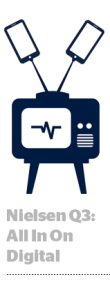 We live in a world of media fragmentation, said Nielsen CEO Mitch Barnes during the company’s Q3 earnings call. And Nielsen, which reported Q3 revenue of $1.6 billion, a YoY increase of 13.3% (excluding its recent acquisitions of consumer research company Arbitron and market research firm Harris Interactive), wants to help measure it.
We live in a world of media fragmentation, said Nielsen CEO Mitch Barnes during the company’s Q3 earnings call. And Nielsen, which reported Q3 revenue of $1.6 billion, a YoY increase of 13.3% (excluding its recent acquisitions of consumer research company Arbitron and market research firm Harris Interactive), wants to help measure it.
Net profits, however, continued their slump from last quarter, falling $91 million from $134 million year-over-year.
“The video landscape is evolving and that creates a growth opportunity for us,” Barnes said. “Fragmentation continues to increase and behavior is shifting as consumers take more control over when and how they choose to view content – and as they do, we see it’s not a zero sum game.”
That’s because, despite flatlining consumption of traditional television, digital video viewing shows no signs of slowing down. According to Adobe’s most recent video benchmark report, online TV viewing shot up 388% year-over-year.
“Choice leads to more, and this is true across every demographic,” Barnes said. “Nielsen is positioned to measure all of that viewing, both traditional TV and digital video.”
All in all, it’s proving to be a busy year for Nielsen. The company introduced mobile measurement functionality for its Online Campaign Ratings (OCR) offering in July, mobile measurement for TV in September and, finally, the beta version of Digital Content Ratings (DCR) in partnership with Adobe, which launched just this past Tuesday.
Overall, there were nearly 10,000 campaigns measured via OCR this year so far, roughly double the number of campaigns for this same time last year. But mobile OCR is still quite new, although Barnes said he’s pleased with growth and client adoption thus far. As the market evolves, he said, Nielsen’s efforts largely revolve around OCR – and mobile is becoming an increasingly significant part of that. Mobile represented about 10% of all impressions measured by Nielsen in Q3.
“It’s still fairly early, but already, the client adoption [of mobile OCR] and usage is very strong,” Barnes said, noting the product’s broad appeal across the industry. Advertisers – Nielsen signed on Hyundai’s business this quarter – traditional media players, digital publishers and even ad platforms all need to measure the impact of mobile.
“Adding mobile coverage was number one on nearly every one of our clients’ lists,” Barnes said.
Investors were particularly interested in Nielsen’s new partnership with Adobe on DCR, the most recent addition to Nielsen’s acronym buffet, which enables mutual clients of the two companies to offer syndicated audience measurement for all forms of digital content using the same measurement architecture as OCR, which calculates audience for ads. Univision, ESPN, Turner Broadcasting and Viacom have all signed on as beta partners.
OCR and DCR are meant to work together, Barnes said; a bit like peanut butter and jelly. A client can use one or the other, but they’re better together.
“Digital content ratings complement and strengthen the value of OCR because it helps agencies and publishers plan and predict OCR outcomes more confidently,” Barnes said.
When asked if Nielsen is planning any other “marquee partnerships” down the line – the company has recently joined forces with a bunch of biggies, including Facebook, Catalina, Simulmedia and, most recently, Adobe – Barnes basically said, hell yeah.
“This is just part of our strategy, to take this open approach to partner with other key third parties in order to provide the best possible solutions for the marketplace,” he said. “You’ve seen us do it in the past [and] you’re going to continue to see us do it.”
There was also a brief discussion of programmatic as an opportunity down the line, though it’s nascent at the moment. But as one investor noted, if anyone has the data to nudge traditional TV players into the world of data-driven TV buying, it’s Nielsen.
“You can be sure that we’re in discussion with all of our big media clients [and] some are more interested in this topic than other,” Barnes said. “It’s still fairly early days for the traditional TV players on this one, but it’s coming.”















